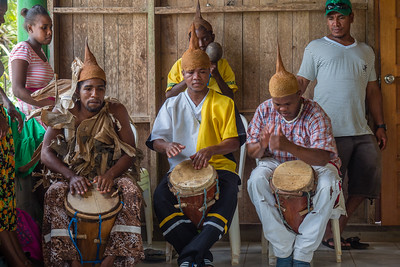The Garifuna People
The Garifuna people, also known as Garinagu, refer to a diaspora of Indigenous Caribbean people descended from the Arawak, African, and Carib peoples.1 According to oral tradition, a slave ship was wrecked on the coast of St. Vincent where intermarriage then occurred between the African slaves and the indigenous Arawak and Carib peoples forming the foundation for the present-day Garifuna diaspora. The story of the Garifuna people is one with a rich history of spirit and resilience in the face of settler-colonial powers. As British soldiers and settlers encroached on Caribbean land, the Garifuna people waged war under Chief Joseph Chatoyer, until his death in 1795. After two more years of decentralized resistance, the remaining Garifuna rebels were exiled by the British from St. Vincent. Those who survived the voyage landed on the Island of Rotan, eventually establishing roots in Honduras and Belize.

Today, the majority of the Garifuna diaspora is scattered throughout Belize, Honduras, and North America. Without a distinct homeland, Garifuna have struggled to retain their cultural practices. In the documentary The Garifuna Journey, one Garifuna elder explains, “It is during the long journey that we rearrange our burden, we want to make much of our Garinagu children, we want them to learn their language…we want them to learn their culture. They are putting down their culture, most of them, so that is our burden now.” 2 Indeed, as expatriates from the United States retire in the Caribbean, and the tourist industry continues to encroach on indigenous land, the risk of displacement and cultural extinction looms larger than ever. Unfortunately, many Central American governments continue to favor protections for industry over indigenous land rights. The 107th amendment to the Honduras constitution, which had previously prohibited land sale to foreigners, was amended in 1998 to make an exception for the tourism industry.3 Similarly, in 2004, new property laws were implemented in Honduras which allowed for the dissolution of communal land titles (such as those held by Garifuna).4 More recently, in 2011 the Honduran government supported Banana Coast Cruise development which dispossessed Garifuna from community lands in Rio Negro.6 Despite the pressure from many directions to surrender their property, Garifuna continue to strengthen their cultural bonds, and in doing so, maintain their historical and spiritual ties to their land.
Punta Rock
Throughout the 1970s and 1980s, there was a period of mass Caribbean migration to the United States, specifically for parents in search of better employment opportunities. This left a gap in generational knowledge, and many young people lost connections to their language and culture. It is within this context that the genre of punta rock emerged in the 1970s and 1980s. A fusion of hip hop, rock, and traditional punta, to some, punta rock’s use of synthesized keyboards and drum machines symbolized a movement away from tradition. However, the duple-meter rhythms that underlay punta rock are indistinguishable from the traditional beats of punta. As ethnomusicologist Oliver N. Greene writes, “For the Garinagu, modernity and the subsequent creation of punta rock did not involve the “shedding of tradition” but rather the maintenance of indigenous Garifuna proverbial ideals through the transformation of a traditional genre of musical expression.” 7 Punta rock’s revolutionary use of traditional elements has encouraged new generations of artists, across genres, to incorporate Garifuna cultural traditions into their work.
Footnotes
- Andrea E. Leland and Kathy Berger, The Garifuna Journey (New Day Films, 1998), https://tufts.kanopy.com/video/garifuna-journey.
- Ibid.
- Nicole Thornton, “Whirlwind Legislature Threatens Garifuna Lands,” Cultural Survival, Mar. 1, 1999, https://www.culturalsurvival.org/publications/cultural-survival-quarterly/whirlwind-legislature-threatens-garifuna-lands.
- Sharlene Mollett, “A Modern Paradise: Garifuna Land, Labor, and Displacement-in-Place,” Latin American Perspectives 41, no. 6 (2014): 27–45, http://www.jstor.org/stable/24573989.
- Keri Brondo, “A Dot on a Map”: Cartographies of Erasure in Garifuna Territory, PoLAR: Political and Legal Anthropology Review 41 (2018): 185-200, https://doi.org/10.1111/plar.12272.
- Oliver N. Greene, “Ethnicity, Modernity, and Retention in the Garifuna Punta,” Black Music Research Journal 22, no. 2, University of Illinois Press (2002): 189–216, https://doi.org/10.2307/1519956.
- Ibid.